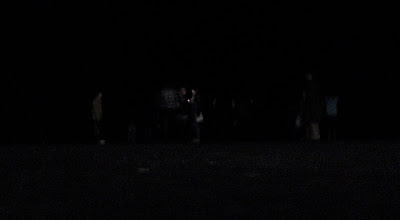I used to spend quite a lot of time with work in London. One upside to the travelling was the ability to keep track of the kind of cultural events that you normally hear about on the news but never stand a chance to experience in Northern Ireland. One such annual tease is the opening of the latest exhibition in the Tate Modern's enormous Turbine Hall.
Back in October 2006, I stumbled upon the press preview of Carsten Höller's Helter Skelter slides and got some early snaps of adult playground.
The next year, Doris Salcedo's Shibboleth consisted of a large crack running the full length of the Turbine Hall's floor. I completely missed last year's Unilever Series exhibition.
However, last week, I spent two days in a workshop in a building that has great views of the Tate Modern across on the other side of the River Thames. So one day at lunchtime I wandered over the Millennium Bridge to investigate this year's madness.

Set on stilts, and called How It Is, Miroslaw Balka has built a huge steel box in the back half of the Turbine Hall, away from the sunlight that streams in the open entrance at the other end. You enter by walking up the gently sloping ramp, and then proceed into the dark void.

As you move in, your eyes adjust to the darkness, and you start to make out other people inside the space. Its walls are covered with soft felt, its roof some eleven or more metres above your head. I walked, drawn into the structure, curious what was at the far end.

For me, the far end arrived with a surprise and a bump as I literally walked into the back wall. And there I stood for a while, looking back at the other people coming up the ramp and gradually being sucked into the darkness.

Walking over to one side, even though I thought I could see the wall, I still bumped into it - perspective and distance are hard to judge when all you've got is black felt to focus on in next to no light!
And in the midst of the normally hands-off London where people pack tube carriages like sardines but still don't acknowledge the existence of any fellow passengers, there was a softening as people brushed against each other or bumped into each other in the dark. "Oh, sorry" people giggled as they collided and passed. Somehow the removal of colour and vision humanised the normally frigid London.
It was lunchtime, and there were a couple of school groups exploring the exhibition. Some people taking flash photos - which makes for a bad photo as well as ruining other visitors' night vision.

On the outside, the 30m long structure seems large. Yet inside in the dark, it has a smaller more intimate feel. Part of me suspected that there's a false back wall? But perhaps not.
Somewhere between art and architecture, what does the dark void ask or say? To me, it makes be wonder about people who find themselves locked in darkness - whether kidnapped or prisioners. People who feel depressed and emotionally dark. Blindness.

No comments:
Post a Comment